#and blueberries and strawberries and gooseberries from the harvest
Text
I need to clean out my freezer for meal train reasons and my brain is just telling me to take the two full bags of cranberries in my freezer and bake tons of orange cranberry breads...which presumably would need to be stored in the freezer.
#i also have 3 cups of sour cherries from this years harvest#and blueberries and strawberries and gooseberries from the harvest#so i guess i need to make smoothies? okay twist my arm why don't you#i already made sour cherry jam to clear out my freezer#why am i obsessed with freezing fruit?
0 notes
Text

+ Garden update~
+ This is a plum tree; after several flowers at the end of winter, he's finally decided to start growing some leaves; I let the clover grow in the pot because I have very little mulch and even less dried leaves to use as cover

+ Rosemary finally has some sun, looking good
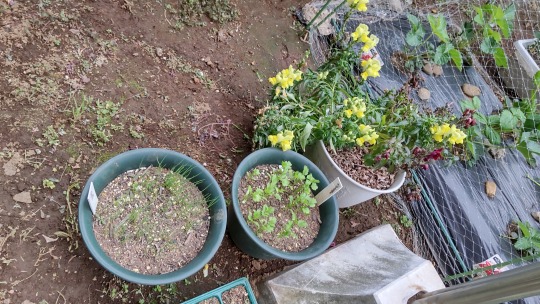
+ Snapdragons finally dying off, but the pots contain chive seedlings and lots of cilantro (needs thinning)
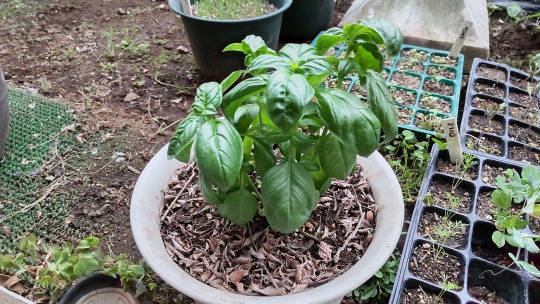
+ Basil; this was store-bought at a sale price, but doing okay
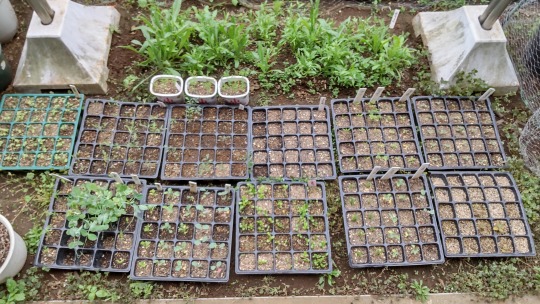
+ Seed trays!
+ Shiso/ooba (Japanese perilla), big tomatoes, cherry tomatoes, blackberries (an experiment, nothing has sprouted), shishito (peppers), chervil, parsley, more cilantro, dill, broccoli, kale, lettuce, gooseberry (all sprouted!!), a few ice plants that I'm hoping will take off with warmer weather, snow peas...
+ The plants at the top of the image are all wildflowers from a packet of seeds from my mom
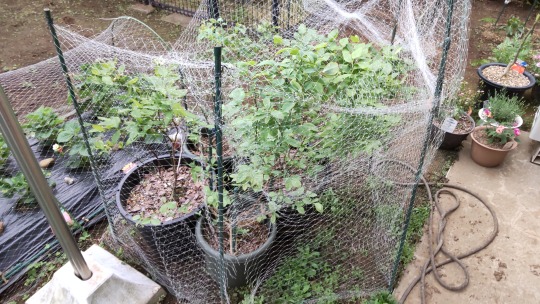
+ Bird netting around the blueberry bushes; the king and queen (Samson and Suksuk) are now accompanied by Starya and Sootakson; the netting is not well-done, it was a mid-workday emergency job since the birds started going for the flower blossoms...

+ Suksuk already blossomed and, I believe, got pollinated by something; at least, it's looking like it's supposed to... the petals turned purple and fell off, and the bottom bit looks like it should

+ Flowers outside Akina's window: lantana and saxifrage plus lavender; the plant is okra, I figured it would grow better with Akina watching over it; the lavender lacks flowers in the photo because I've harvested the first batch and am currently drying them (for making London Fog)
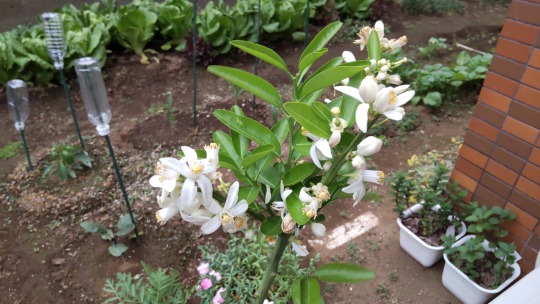
+ This is iyokan, a Japanese citrus; like any citrus, its flowers smell amazing...
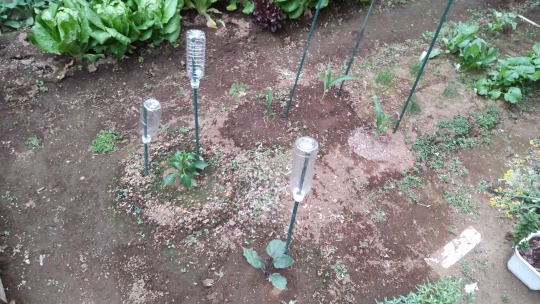
+ A Japanese bell pepper, eggplant, and three corn... like, regular corn; The eggplant is not doing well, not sure what's wrong

+ Oh! The persimmon "tree" is still alive! He's been making leaves, which is incredible, because when I transplanted it, it had no healthy roots and was just a dead stick; trees are great
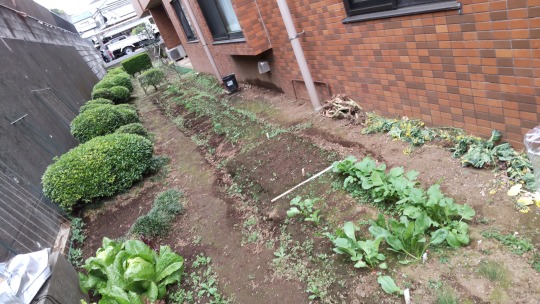
+ The side plot... radishes (about ready to harvest), beets, a small amount of spinach, carrots, and edamame (soy beans); the scraps on the right are there drying out to be used in compost
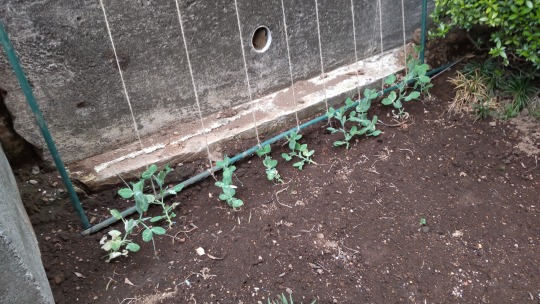
+ Snow peas from a seed pack from my mom

+ Edamame (soy beans) from our landlord... He asked how many I wanted, I told him 12, he told me to take 20, I told him I don't have room for 20, he told me to take 15, I took 15... But three of them have died so now I have 12
+ They are growing surprisingly fast...
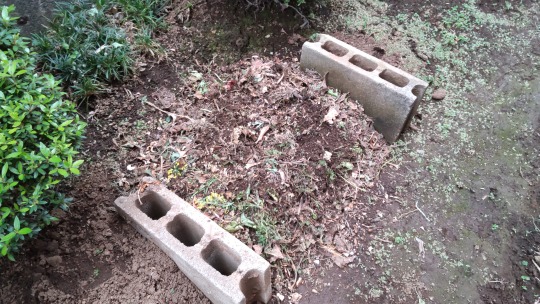
+ I have started a more proper composting area
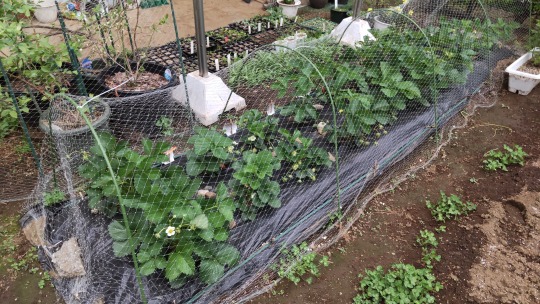
+ Finally, the strawberries! We have gotten six tiny little berries so far from a set of four plants; the berries were small but very sweet

+ But the bigger berries on the bigger plants are starting to come in and most of the other plants have lots of flowers...
+ This concludes your garden update
3 notes
·
View notes
Text
the peaches on my peach tree are actually getting big! today got rly warm and they're starting to swell up. i mean the biggest are abt the size of a quarter, but still. the sheer number of them and the fact that so many are really developing nicely is so exciting
and im replacing the invasive blackberry with a native marionberry and this is the marionberry's first year of having rly, rly spread out, significant growth. covered in buds and some already open!
actual strawberries beginning to develop in the sprawling strawberry patches, blackberries flowering from the massive plant on the nearby apartment complex's property bc if i can't fight it i might as well get some berries from it
goji and gooseberries both showing good growth, 2 of the 3 blueberries flowering a fair bit, and the raspberry patch spreading like wildfire and covered in blooms, it's gonna be an intense year for raspberries
actually tho its gonna be an intense year for all berries. some carrots in the ground, myriad herbs and microgreens (not so micro, they can grow into bushes), and specifically so much kale and sorrel
the nice neighbors mowed the shared patch where my native miners lettuce had seeded, but all that did was give a perfect open spot for even more miners lettuce. i wasnt too into the flavor and it's hard to harvest anyway bc awful neighbor's dog shits there every few days, but it's still pretty and native edible greens that provide for local pollinators > fucking grass
1 note
·
View note
Text
For thousands of years, over 30 types of berries have been harvested in traditional territories of British Columbia from early summer (soapberries, salmonberries, thimbleberries), to late fall (cranberries, crabapples), depending on the berry type and location. Berries were an important part of traditional knowledge. First Nations peoples were shown when the berries were ripe by listening and observing the changes in the animals and plants. The wild rose blooming announced the readiness of sxusem (soapberries) for Nlaka'pamux. The song of Swainson's thrush heralded the ripening of salmonberries for Tlingit, Tsimshian, Haida, Haisla, Oweekeno, Squamish, Nuu-chah-nulth, Ditidaht, and Northern Straits Salish people. Soapberries hold a high place and have a lasting taste memory. Saponins in the soapberries allow them to be whipped up into a frothy 'ice cream' which was traditionally eaten in British Columbia. Small spoonfuls are taken as the taste is bitter and a little bit of soapberries goes a long way in cleansing the mouth and helping digestion. So-called 'Indian' ice cream has often been mixed in with dried meat, or may be served alone. More recently, soapberries have been mixed with sugar and added to carbonated water as an alternative to pop. Berries are an important source of vitamin C, fibre, carbohydrates and have many medicinal properties: wild blueberries and cranberries have anti-bacterial properties; while rosehips and blackberries are high in antioxidants which help to boost the immune system.
Traditionally harvested berries
North Coast: bunchberries, blueberries, cloudberries, cranberries, crowberries (mossberries), currant, gooseberry, blue elderberry, red huckleberry, salmonberry, thimbleberries (Rubus parviflorus), black hawthorn (jam/jelly), crabapple (jam/jelly), oregon grape (jam/jelly), soapberries, strawberry
South Coast: cranberries, red huckleberries, salmonberries, thimbleberries, strawberry, oregon grape (jam/jelly), cherries, currants, blackberries, gooseberries, soapberries, strawberries
Southern interior: blueberries, cranberries, currants, blue huckleberries/bilberry (Vaccinium deliciosum), blue elderberry, soapberries, black raspberry, strawberries
Northern interior: blueberries, cranberries, blue huckleberries/bilberry, crowberries (mossberry), currants, bunchberries, cloudberries.
7 notes
·
View notes
Text
SIMPLE PLEASURES
Let’s talk FOOD
HOLY SHIT IVE BEEN EATING DRIED FRUITS for the past decade...ever since I’ve sold them behind the counter...weighing quarter lb minimums...
unboxing wholesale dried fruit - gooseberries, blueberries, strawberries, mangos, figs, dates, ETC YOU GET MY DRIFT
I’m an avid fruit consumer and aficionado and yesterday in my rare moments of wandering whole foods in search of exquisite delicacies have finally PAID OFF. IT IS THAT SERIOUS because when you’ve eaten as much dried fruit as I have, you begin to really chase the best quality...and most of it...isn’t all that fresh, it’s just not all that. Take it from someone who is very particular. Especially in the realm of food in which I have worked behind some of the most popular counters in NYC.
I ordered from Nuts.com and I was like ok if this is the best of the best, this will suffice ....it was better than the usual 7-11, grocery store dives but the organic fruit variety was very disappointing, fermented, and offensive to my taste buds. Surely, someone can do it better. AND THEY DID
ORGANIC INTERNATIONAL HARVEST SHOUT OUT TO THE BEST DRIED FIGS I HAVE EVER FUCKING HAD. The darker the fig, the sweeter and it is not my bread and butter, it’s edible but I have always preferred them to be beige, off white because those carry the best texture and most fulfilling subtly of sweetness and fullness. COMPLETELY MIND BLOWING THANK YOU SO MUCH I WILL CONTINUE TO SEEK THESE OUT IN WHOLE FOODS AND PAY WHATEVER THE HELL YOU WANT FOR THEM BECAUSE THE QUALITY IS UNMATCHED. OUT OF THIS WORLD. THANK YOU FOR DOING FIGS...THE RIGHT WAY.
SHOUT OUT - SOLELY.COM BEST DAMN DRIED MANGOS. I THINK I HAVE SAID ENOUGH BECAUSE THE WAY THAT I CONSUME DRIED MANGOS, ITS BEYOND UNREAL. IT IS MY SALVATION FROM THE WORLD. IT IS MY RAY OF SUNSHINE IN DARK DAYS. THESE ARE SPECTUALAR. I AM BROUGHT DOWN TO MY KNEES IN THE AMOUNT OF GREATNESS THESE MANGOS ARE GIVING ME RIGHT NOW. I HAVE HALF A BAG LEFT AT WORK, 1 FULL BAG IN MY BAG, I SHARED THE LAST BAG AND NOW ALL I CAN THINK ABOUT IS HOW TO OBTAIN MORE BAGS BECAUSE QUALITY, ON POINT YOU CAN NOT FUCK WITH THAT SHIT. THE CAPS INDICATE MY RAW APPRECIATION AND enthusiasm FOR THE BEST DAMN DRIED MANGOS EVERRRRRRRRRRR IN THIS DECADE THAT I HAVE EATEN. STORE AFTER STORE. ONLINE PURCHASE AFTER ANOTHER. SEARCHING FOR THE HOLY GRAIL OF TWO OF MY FAVORITE DRIED FRUITS EVER MADE...THANK YOU BOTH. YOU MADE MY LIFE COMPLETE AND NOW I KNOW THAT THE BEST DOES EXIST AND EVERYONE WHO LOVES FIGS AND MANGOS IN THE INSANE WAY THAT I DO DESERVE TO KNOW, I DID THE RESEARCH, THIS IS IT!
0 notes
Text
Grow Your Own – August advice and gardening tips
Watch for dry weather
Top tips
You're reading: Grow Your Own – August advice and gardening tips
Water well during dry spells. Irregular watering can lead to problems with blossom end rot in tomatoes, splitting of root vegetables
Sowing and planting
Fruit
Plant out rooted strawberry runners.
Vegetables
In the south of England you can still sow quick maturing salad crops such as summer lettuce, radish, rocket, sorrel, chicory and fennel.
Continue to sow spring cabbage, turnips, Oriental vegetables and overwintering onions, in the south of England.
Sow green manures such as crimson clover and Italian ryegrass to act as a soil improver and to cover bare areas. When dug in, they conserve nutrients and improve soil texture.
Pruning and training
Fruit
Summer prune sideshoots on restricted trees (such as espaliers and fans) to three to four leaves to form fruiting spurs.
Summer prune restricted apples and pears.
If necessary, prune nectarines, apricots and peaches after they have fruited.
If necessary, prune plums, gages and damsons immediately after harvest.
Water cranberries, lingonberries and blueberries regularly with rainwater. Tap water will do if butts run dry.
Read more: Eight Eggplant Recipes You’ll Love
Loosely tie together new blackberries and hybrid berry canes.
Remove straw and old leaves and tidy up strawberries after fruiting.
Prune out fruited summer raspberry canes and tie in new ones.
Problems
Check plants regularly for aphids and deal with them as soon as you see them.
Look out for tomato and potato blight and deal with it as soon as you spot it.
Watch tomatoes for blossom end rot, and other ripening problems.
Look out for fungal spots on bean and pea pods and leaves.
Remove any sweetcorn cobs affected by smut.
Carrot fly is still about.
Check stored onions for softness and the grey or black mould of neck rot.
Deal with brown rot on tree fruit.
Protect grapes from wasps.
Deal with powdery mildew on grapes and melons.
General care
Vegetables
Irregular watering can lead to problems with blossom end rot in tomatoes, splitting of root vegetables and flower abortion in runner beans. Help prevent this by watering well during dry spells.
Weeds can also compete with vegetables for water, and act as hosts for pests and diseases, so remove regularly by hoeing.
Marrows should be raised off the ground slightly, to prevent them discolouring from contact with the soil.
Continue earthing up celery, putting a layer of paper between the stems and the soil.
Take care when thinning out any late-sown carrot seedlings to prevent the scent released attracting carrot fly females.
Ready to harvest
Fruits
Plums & damsons
Early apples & pears
Perpetual strawberries
Blackberries & raspberries
Blueberries
Gooseberries
Currants
Figs
Early grapes
Read more: Top 10 Vegetables To Grow Over Winter
Vegetables
Onions, garlic & shallots
French & runner beans
Courgettes
Cucumbers
Tomatoes
Potatoes
Sweetcorn
Buy seeds & plants online
Get your seeds & seedlings directly from the RHS Plants Shop

Shop now
Get involved
The Royal Horticultural Society is the UK’s leading gardening charity. We aim to enrich everyone’s life through plants, and make the UK a greener and more beautiful place.
Source: https://livingcorner.com.au
Category: Garden
source https://livingcorner.com.au/grow-your-own-august-advice-and-gardening-tips/
0 notes
Text
Cap 175 : Bayas o Arándanos salvajes de Beringia que comían los Paleoindios en la Edad de Hielo
.
*********************
.
Debajo de las Fotos de las Principales Bayas Salvajes de Alaska ( Arándanos ) en esta Página ves un Video maravilloso hecho con Ayuda del Departamento de Agricultura de Estados Unidos. Son un par de Señoras Botánicas muy inteligentes y científicas que nos llevan a coger Bayas salvajes, nos explican todo muy claro. nos dicen cuales son las mas deliciosas y nos enseñan a guardarlas en Nevera para hacer deliciosas Mermeladas, Conservas, Jams, Postres, Bizcochos o Cakes, etc ..
Y hay otros dos Videos de Familias que viven el Sueño Alaskiano en Contacto con la Naturaleza. Nos enseñan Botánica y Cocina con Bayas para hacer Tortas y Mermeladas de Arándanos.
Si vivimos en Regiones mas calientes que Alaska, a lo mejor también tenemos mucha Profusión natural de Bayas como Alaska o podemos importar las Semillas que convengan de Alaska o de otra Parte, y gozar de la buena Cocina y la buena Mesa si las cultivamos. O hasta ponemos Negocio y Ventas.
Los Arqueólogos taladrando la Tierra y el Mar sacan Sedimentos del Pasado y nos dicen que estas Bayas existieron para los Paleoindios que inauguraban a América.
.
A Continuación una Galería de Frutas comestibles por Humanos que dan en Verano en Alaska y que seguramente existían en Beringia y en las Islas de la Costa del Pacífico de Canadá y Estados Unidos cuando llegan Paleoindios.
.
Vaccinium uliginosum = Bog Blueberry = Arándano de Pantano
.

.
Próxima Foto = Crowberry (Empetrum nigrum) = Bayas de Cuervo, o Bayas Negras.
.
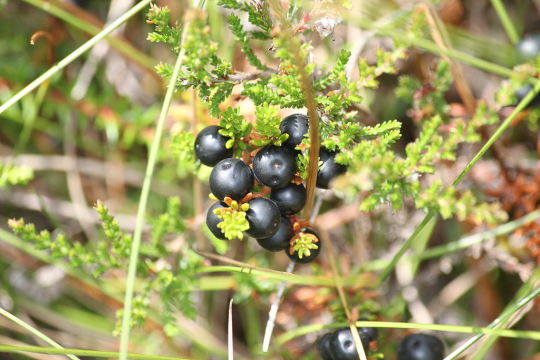
.
Low-bush Cranberry (Vaccinium vitis idaea) = Arándano Rojo de Mata baja.
.

.
Sigue : Salmonberry (Rubus chamemorous) = Baya Salmón o Baya de Nube.
.

.
Más Información sobre Bayas o Arándanos de Alaska, que muy seguramente comieron los primeros Paleoindios al llegar a América, por Alaska o por Islas :
Bering Land Bridge = Wild Berries
https://www.nps.gov/bela/learn/nature/wild-berries.htm
.
*********************
Plantas buenas de Alaska y Beringia = No venenosas y recomendadas para Paleoindios que van para el Sur
.
Rubus parviflorus = thimbleberry = Baya Dedal
.

.
Cornus canadensis = Bunchberry = Cornel Canadiense, Baya de montoncitos
.
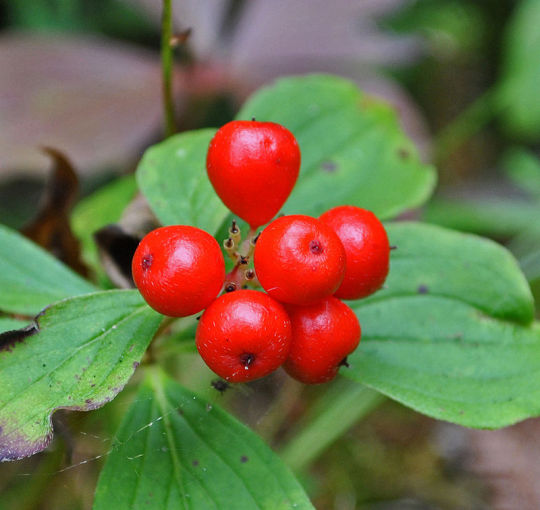
.
Huckleberry = Solanum melanocerasum
.

.
.
*********************
.
Las Plantas peligrosas venenosas tóxicas que te pueden matar en Alaska. Mejor que no te pierdas lejos de la Civilización. Los Paleoindios tenían que distinguirlas y comer las buenas y no las malas.
.
Foraging in Alaska
It would be wrong to say that berries are a safe bet due to the prevalence of baneberries and snowberries, which can be fatal. But Alaska does offer a bounty of berries that, if found, will provide key nutrients wherever you are in the Last Frontier. Edible berries in Alaska include: lowbush cranberry, thimbleberry, strawberry, salmonberry, bunchberry, huckleberry, highbush cranberry, gooseberry, elderberry, cloudberry, twisted stalk/wild cucumber/watermelon berry and the Alaskan blueberry.
Baneberries: These red or white berries are poisonous and can cause cardiac arrest.
Devil’s Club: This plant has numerous spines that can break off easily and the plant is toxic to humans if consumed.
Snowberry: Often consumed by birds, this berry is unfortunately poisonous to humans. The berries contain alkaloids that cause vomiting and dizziness.
Cow parsnip/hogweed: Skin contact with the various phototoxic chemicals found in this plant can cause dermatitis, which can range from a mild red rash to severe blistering.
.
How To Survive In The Alaskan Wilderness
https://www.alaskawild.org/blog/how-to-survive-in-the-alaskan-wilderness/
.
*********************
.
Actaea rubra = (Aiton) Willd Red Baneberry = Baya Fatal Roja. Muy venenosa te puede matar. De la Flora y Vegetación de Alaska.
.

.
Actaea pachypoda = white baneberry or doll’s-eyes = Baya Fatal Blanca o Ojos de Muñeca. Otra Baya de Alaska y Beringia que hubiera matado a los Paleoindios.
.

.
Próxima Foto : Symphoricarpos albus = Snowberry = Baya de Nieve venenosa. Una vez que los Paleoindios en Beringia se vomitaban y se mareaban con esta Fruta tóxica no la volvían a comer nunca mas. Abundante en Alaska y Norte de Canadá. Creen algunos Científicos que los Paleoindios pudieron estar detenidos un Tiempo de hasta Milenios en Beringia antes de ir mas al Sur. ( En Bote o caminando ).
.

.
*********************
.
Este es el Video Maravilloso del Departamento de Agricultura USA. Con las dos Señora botánicas científicas, pero también muy queridas, amables y prácticas y nos enseñan los Secretos para recoger las Bayas y hacer los Platos mas delicioso del Mundo.
.
Collecting and Using Alaska's Wild Berries
Preserving Alaska's Bounty. Supported by U.S. Department of Agriculture special project 2005-45066-03294 for $318,075 and related grants 2004-45066-03027 ($256,671) and 2006-45066-03533 ($314,582). This DVD will help you learn to identify the many species of edible Alaska wild berries and show you how to avoid poisonous species. You'll also learn to identify habitats where your favorite berries grow and, once you've picked them, how to clean, freeze and can them for storage.
.
youtube
.
*********************
.
Esta Simpática y hermosa Familia nos enseña a distinguir las Blueberries de las Huckleberries y otras Bayas o Arándanos.
PICKING BERRIES IN ALASKA - Bramante Brothers Off Grid - Oct 2020
NOT THE BERRIES YOU THINK!...Picking berries in Alaska can include a dozen or more edible berries, but in this Bramante Brothers off grid vlog we go after the quite rare......well, watch the video to find out.
..
youtube
.
Aquí vemos el Paisaje de Alaska en buen recorrido, hay Tundra que es Pantano sin Arboles y con muchos Musgos, Líquenes, Helechos. Cogemos varias Clases de Bayas.
Una generosa Dama nos enseña a hacer Bizcochos, Tortas o Cakes, con WaterMelon Berries, Crowberries y Blueberries, les echa Harina, Polvo de Hornear, Salsa de Manzana, Aceite de Coco, Azúcar y Vainilla. La Señora seca Hojas y Flores para hacer Te Herbal.
Exploring Beautiful Alaska | Harvesting Wild Edibles - August 2019 - Simple Living Alaska
We head out on our Polaris Ranger to sight in our hunting rifle for the upcoming moose season, admist the spectacular journey, we find time to harvest a variety of wild berries and wildflowers.
.
youtube
0 notes
Text
Buy berry fruit seeds Australia
Everyone loves to eat berries. Berries are among the healthiest fruits in the world. They are different in taste, color, shape and nutrients. But most of the people like to eat berries and grow berry fruit seeds in Australia. Even in a small space with compatible weather conditions, berry fruit seeds Australia can be grown. Not only different types of berry seeds but also different labels of berry fruit seeds Australia are available.
Most people refer to organic, heirloom or hybrid berry fruit seeds Australia. A variety of dishes, beverages, salads, sweets and much more are prepared using berries. Using the harvest of home grown berry fruit seeds Australia, brings more taste and health benefits.
What are berry fruit seeds Australia?
Berries are named as fruits with high nutritional values and taste. They are fruits with a pulpy, juicy, brightly colored edible fruit. Different types of berries carry different tastes. Some berries are sweet, sour, bitter or tart. There is no pit or stone in berries. Small seeds are found in the berry fruits and it is easy to get berry fruit seeds Australia for more production. There are over 400 different types of berry fruit seeds Australia with a range of colors, shapes and taste.
The types of berry fruit seeds Australia
One can like a certain type of berry and some other can dislike it. But it is very rare to find a person who dislikes all types of berries. The classification of berry fruit seeds Australia is over 400 types. The color, taste, size and shape majorly affect the categorization. Major types of berry fruit seeds Australia are,
Strawberry
Black berry
Blueberry
Raspberry
Cranberry
Acai
Boysenberry
Gooseberry
Huckleberry
Goji berry
Growing conditions of berry fruit seeds Australia
The main advantage of growing berry fruit seeds Australia is that they can be grown both on the ground as well as in containers. Berry trees are not large trees so they do not require much space. If the berry fruit seeds are given the necessary factors of growth and good maintenance, the plants will produce more healthy berries.
Berries do not require much light for germination at the beginning stage. Dampness is a major factor required by berry seeds to germinate. The ready to grow and prepared berry seeds should be sown on seed starter soil. You can grow the seeds in a container or on the ground by preparing a high patch. Next sprinkle a thin layer of soil and leave the seeds in the dark. Do not sow the seeds too deep into the soil because the seed coating is thin and it needs light and enough oxygen. Keep the soil moist and when the soil appears dry, water the soil gently. The seedlings will begin to sprout and then expose the plants to enough light.
Healthy and delicious berry recipes
Food and beverages prepared using berries are very delicious. Thousands of recipes are made using different types of berries. Hand picked berries from homegrown berry fruit seeds Australia gives more taste. If you are a berry lover, do not miss out on these yummy recipes.
Raspberry - Ricotta toasts
Baked berry oatmeal
Berry granola smoothie
Berry smoothie bowls
Blueberry bottom yogurt
Blueberry - Ricotta pancakes
Quick berry jam
Strawberry butter
Berry pavlova
Berry trifle
0 notes
Photo

HOW TO GROW YOUR OWN ENDLESS SUPPLY OF BERRIES Growing berries is one of the easiest ways to produce nutritious home grown food! If you’ve ever found wild strawberries or blackberries you will realize that these plants will generally produce fruit without our intervention. However, certain techniques will help you get the best crops. Many fruit bushes are hardy and tolerant to a variety of soil conditions – once they are established, they will need very little maintenance and will supply you with delicious berries for many years. Don’t worry if you have only a small yard or patio – soft fruit is well suited to container growing! You will also quickly notice that humans aren’t the only creatures that enjoy berries – and it is likely that you will require netting to keep birds off strawberries and raspberries. It could take a few years to establish a fruit garden to provide enough produce to last all year round, but before you go out and buy your plants, take a moment to find out which ones will grow best in your climate and if they require any special treatment – consider the size of the full-grown plants, soil type, pH, moisture levels and amount of sun required. We will focus on those that grow well in a temperate climate… so let’s look at how to grow some of the more common berries and a few of the unusual ones! STRAWBERRIES: Strawberries are easy to grow, preferring a sunny location. Each plant will bear runners that can be separated and planted in a new plot after three or four years – this helps to prevent disease. Add a mulch of straw when the fruits first develop to keep them clean, or grow them through plastic sheeting. They like a well-drained, fertile soil. BLACKBERRIES: You might be lucky enough to find a good crop of wild blackberries near your home but be wary of blackberries in “civilization” as they might be contaminated by traffic pollution, chemical sprays or even polluted soil. It’s always worth learning about the history of the place you are foraging from…. Fortunately, blackberries are easy to grow at home. If anything, they are too easy and the main goal is to keep them from going crazy! There are thornless varieties available that produce large fruits on the one year old stems – annual pruning in the fall is necessary to remove the stems that have finished fruiting. Tie up the new stems to wires or trellis to keep them tidy and off the ground. RASPBERRIES: Raspberries, Tayberries, Boysenberries (less cold-tolerant) and Loganberries are all very similar in growth and requirements. There are two main types of raspberries; summer- and autumn-fruiting. Prune summer varieties in the fall and autumn-fruiting ones in late winter – new stems need to be tied up to a trellis or wires every year. BLUEBERRIES: Blueberries are very hardy but need an acid soil, with a pH of 5.5 or less so you will need to add sulfur chips or used coffee grounds to a neutral soil before planting – they would be ideal for growing in containers as acidic (ericaceous) soil can be used. They also need damp ground – why not try growing them in a old bath tub (with the plug out!) or similar large container buried in the garden! This allows for good water retention in the soil. GOOSEBERRIES: These are very hardy plants that need only an occasional mulch and a yearly trim to keep their shape – aim for an open “goblet” shape to allow light and air to circulate and to improve pollination. BLACKCURRENTS: These are classified as berries and are closely related to gooseberries – they can grow in partial shade and prefer a damp, fertile soil, being drought intolerant. They require a soil acidity level around pH6. Regular mulching is helpful to keep competitive weeds at bay – grass cuttings are good as long as they are not applied in contact with the stems. Pruning is done in late fall to late winter to remove old or weak wood and to maintain a goblet-like shape. Blackcurrants are very versatile in cooking, they are high in pectin so make an easy jam or jelly (also good to add to other fruit to help with setting) and provide a great source of Vitamin C and anthocyanins! Redcurrants and Whitecurrants are very similar to grow and add some color and variety to your diet! GOJI BERRIES: There is one available variety of this Super-food berry and it is surprisingly easy to grow at home if you have a sunny area! Goji bushes need a well-drained compost-enriched soil and pruning in early spring. They grow best when trained against a wall or fence. They are a great choice for a coastal garden because they are tolerant to salt-laden air. Most berries have a short cropping season so in order to enjoy them all year round, you will need to look at ways to preserve them. A deep freeze is probably the simplest solution and it is a surprisingly good method for retaining vitamins and health-giving phytonutrients, especially in good quality, organically grown berries. For best results, the crop should be frozen as soon as possible after harvesting and in airtight food grade containers – the fruit will be good for up to 6 months. Other methods include canning, bottling and making preserves – if the jars are well sterilized, these will keep for at least a year.
17 notes
·
View notes
Text
Masina’s Profile
Name: Masina
Species: Misumena Vatia
Sex: Female
Age: 17
Siblings: Talia
Likes: Gardening, flowering plants, summer & growing fruit
Dislikes: Rotten kids, flooding, people who have no respect for nature & forest fires
Personality: Caring/Super Sweet
Info: The new neighbor on Cardis Yukan's block, Masina is a flower-loving spider who is a immigrant from the tropics. She shares a household with her younger 11 year old sister known as Talia. Masina is best known for her green thumb and has a average size garden for of all kinds of floweing plants and she occasionally grows & harvests fruits such as strawberries, raspberries, blueberries & gooseberries. Overall, Masina is a beautiful nature loving spider who is considered to be very attractive.

0 notes
Text
Brian Minter: Plant small berries for a tasty treat

COVID-19 has created a shift in our thinking and priorities, and more people have become focused on planting their own gardens this spring. In terms of food security, what can we plant in our gardens now, apart from traditional vegetables, and expect a crop this year? Not a two-year-old fruit tree — it would still need a couple more years before it could provide a crop. However, many small fruits, especially larger-sized plants, can give you something tasty to enjoy this season.
Everbearing strawberries, for example, planted now will produce a reasonably good crop this year. I love their versatility to perform well in containers, hanging baskets and gardens. Varieties, like “Albion”, “Quinault”, “Eversweet” and “Seascape” are among the best. Day-neutral varieties, like “Tristar”, are also excellent and produce over a very long period. Most strawberries are started from “runners”, but many growers today are using seed varieties which, when started very early, will also produce nice crops all season long. Varieties, such as “Berri Basket” and “Berries Galore”, will have beautiful pink or red flowers for some added colour.
Everbearing raspberry production has surged in the past few years. While main season varieties, planted now, will produce sucker growth for next season’s harvest, everbearing varieties produce fruit on this year’s shoots that come out of the root system below. Older varieties, like “Heritage”, are now being replaced by newer, more productive varieties with larger berries, such as “Autumn Bliss” and the new hottie “Cascade Delight”. “Fall Gold”, an older yellow variety, remains very popular because of its mild but sweet flavour. These varieties can be planted in the ground or in larger containers. “Raspberry Shortcake” is an attractive container variety that is very compact and produces tasty berries, but it is not as productive as everbearing varieties.
Well-draining soil is a must for raspberries as they hate wet feet. Planting four or five canes in a larger container will get you a fairly good crop this year. Be sure to cut your canes back to about 10 cm (four inches) to encourage new shoots to develop. Adding composted manures to your soil and using slow-release fertilizer will help achieve a more continuous production. In colder areas, mulch them heavily for winter protection.
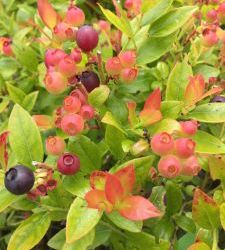
Blueberries round out the top three favourite small fruits, and there have been some positive changes here as well. I always suggest planting early, mid-season and late varieties together for a more constant supply of berries. Vaccinium “Early Blue” is one of the earliest to produce. The mid-season favourites are “Blue Crop”, “Duke”, “Reka” and “Chandler”, which has the largest berries of all. “Elliot” is the last variety to ripen, giving you fruit well into September. Although the berries are smaller, a newer variety, called “Perpetua”, is amazing. One of the earliest to produce, it keeps going well into fall. For very cold areas, “North Blue” and “North Country” are hardy to Zone 3.
In terms of space, some innovative growers are planting three varieties together, both for good pollination and for extended production times. It’s a great idea and one you can do yourself by picking the varieties you want and growing them together as one plant.
Blueberries grow nicely in containers if they have well-draining soils and have fine fir or hemlock bark mulch worked into the mix. To maintain good health and steady fruit bearing, make sure your blueberries are well fed by applying a slow-release fertilizer, like 14-14-14.
Even though the Lower Mainland, the Fraser Valley and Vancouver Island have an abundance of “thorny” blackberries growing wild, “thornless” blackberries are the fourth most popular garden fruit. They are not as invasive as their prickly cousins and when grown espaliered on a fence or trellis, they will give you a considerable quantity of fruit the first year, especially if the plants are larger in size. Over the years to come, they will provide a profusion of large, sweet, delicious fruits. “Black Satin” is one of the favourite varieties and for colder areas of the province, “Chester” is the hardiest. If size matters, the “Prime-Ark Traveler” has huge, eye-popping fruits.
A whole range of novelty fruits, such as jostaberries (a black currant and gooseberry cross), tayberries (a blackberry and raspberry cross), “Munger” black raspberries and haskap berries, will produce fruit this year. Elderberries, with their high antioxidant content, will provide berries for preserves and wine. Today, vastly improved varieties of most small fruits are readily available, and they will perform exceedingly well. In these challenging times, if you have a garden or a sunny patio pot, all of these fruits are not only a great food investment, but you’ll also love harvesting your own home-grown bounty.
Brian Minter: Plant small berries for a tasty treat published first on https://weedkillerguide.tumblr.com/
0 notes
Text
excuse me while i dive into excessive detail abt my garden :')
cracks knuckles
so. so. we moved here smth like 9 years ago, at which point the previous owners had a chicken coop and wooden deck taking up most of the backyard. (side note: i'm almost certain there wasn't adequate space for the chickens)
credit goes to my mom for a lot of the major renovation into what it is now. the wooden deck was rotting and becoming increasingly dangerous, so with my brothers helping they all tore down the entire deck. it took a lot of time to physically stabilize and level the yard enough for it to be at least semi-functional after that, but we eventually ended up with a section of paver stones and a wide area of open soil
so much trial and error during these stages that im not going into bc im writing a blog post, not a novella, but suffice to say my current success was not easily or quickly won. i think the major turning point was when i did a "lasagna"/sheet mulch on the would-be garden area to enrich the soil, bc that was rly the first, big mark i made on the area
from there, it's grown finally into two planting beds made of those concrete blocks with 2 big holes cut out, which is important bc i wanted to and now have planted a ton in these "planting pockets" as i call them. they're marvelously appropriate for microgreens and also to keep track of small bulbs i want to see bloom but can't decide where to place permanently, lmao
in the last, idk, maybe 2 years ive rly leaned into it hard. now i have prolific blackberries, and i'm cutting down all the blackberries along the side yard after this season so the marionberry can replace it - natives > invasives, after all. (not that i can stop the blackberries from growing - they're all over the place, incl a lot of other ppl's property and sneaking over)
at the same time, my blueberry trio will have thoroughly established and my red raspberry should be doing great, considering how many berries we got off it this year, the year we bought it. goji berries are growing but slowly, so i'm not expecting much, but the gooseberry is taking off again. so wild, i love it. and the prickly pear cactus suffered root rot and i almost lost it, but i believe ive successfully rooted the topmost segment. it'll take time but i should eventually be able to try the cactus fruit. years tho.
also all my strawberry groundcover layers are doing rly well, and i get the occasional strawberry off them, tho they're mostly for evaporation control. it's still a challenge to grow a lot of veggies bc it's just not hot enough for them here, but im still doing rly good overall
oh, and my lemon tree is doing outrageously well... this year it's putting out leaves longer and wider than my hand. that's new. and the baby lemon tree i grew from seed from the first-ever harvested lemon from the original tree is putting out So Fucking Much new growth, i'm thrilled
my various planting areas are doing super well, too. rly beginning to fill them in. i have pink jasmine trellising by the front door and it's getting so full; two kinds of lilac along the front path; newly, a pretty and fragrant pink-blooming weigela shrub. three canna lillies (which aren't actual lillies, which i refuse to grow anywhere bc they're immensely toxic to cats) all with different flowers, and for the first time i found some seeds before they had developed their rly hard outer shell, so i'm trying to grow some more from seed. exciting!
im quite confident that the front long & skinny & hella shallow planter will have its usual forest of arugula, endive, and sage - but will hopefully also have miners lettuce. oh and the mum that somehow became a giant shrub in a tiny pot set in said long planter. ive had to brace it multiple times, it's sheer size is unreal
and im discovering that hellebores in our area remain evergreen thru summer after they're 2nd-3rd established year. just the leaves ofc, but it's still rly cool, i'm so proud of them. and i finally have some outdoor ferns that have stabilized and come back multiple times!
1 note
·
View note
Text
What to Grow In Your Miniature Garden

Having a small garden means that you have less space and limited growing options, because let’s face it cannot grow huge trees in a square foot garden. Some plants and vegetables need room to breathe and expand their stems and roots. If you don’t provide them the required space, they can take over other plants and destroy them in the process too. Hence,
you need to be very selective about the things that you want to grow in your miniature garden. Don’t be disappointed because you cannot grow huge trees in your garden but you can still grow a lot of fruits, vegetables and fragrant plants in your square foot gardening. You can use these fresh vegetables and fruits to make salads daily. Fresh food always tastes better, plus, it is healthy. So, you get dual benefits with a single effort. Whether your garden is 4 foot by 4 foot or 2 foot by 3 foot in size, the plant's mentioned here are suitable for both sizes. Here is an extensive list of things that you can grow in your square foot garden.
Summer Vegetables
Not all vegetables are present in the market all year long, unless they are exported, but those are way too expensive. Very few vegetables have the privilege of growing throughout the year such as tomatoes, potatoes, etc. However, the plantation methods are different for both seasons but the growth of these vegetables is in full swing in a particular season.
Here is a list of vegetables that you can grow in your square foot garden in the summer season. Besides them we have mentioned the number of squares they may consume; however, that is tentative. (1 square = 1 sq. ft)
Beets (16 plants in 1 square) Bell Peppers (1 square) Broccoli (1 square) Bush Beans (8 plants in 1 square) Carrots (1 square) Cucumber (3 squares) Eggplant (1 square) Green Onions (16 plants in 1 square)) Kohlrabi (1 square) Lettuce (4 plants in 1 square) Potatoes (1 square) Radish (16 plants in 1 square) Spinach (8 plants in 1 square) Sweet Corn (1 square) Tomatoes (1 square) Zucchini (9 squares)
Winter Vegetables
In winter, staying in the sun and experimenting with your garden can be a lot of fun. If you live in an area where frosting is a common issue, then you need to harvest these plants a few weeks before the frost date. Here is a list of vegetables that you can grow in the winter season. The square size mentioned here is identical to the one mentioned in the previous topic.
Asparagus (1 square) Broccoli (1 square) Cabbage (2 squares) Carrots (1 square) Celery (3 squares) Collard Greens (2 squares) Kale (1 square) Leeks (1 square) Parsnips (2 squares) Parsley (2 squares) Rutabagas (2 squares) Sweet Potatoes (1 square) Swiss Chard (1 square) Turnips (2 squares)
Some Common Herbs
You can make your square foot garden rich in herbs and diversify your food life at the same time. People usually have personal preferences when it comes to growing herbs. Some like the taste of thyme in their food while others like to make it healthy by adding cilantro. Here are some herbs that can be grown in small spaces.
Oregano – This herb should be harvested in fall. It will take 2 to 3 weeks to grow and emerge from the soil. A single plant should be harvested in one square. Moreover, it acts as a repellent for cabbage butterfly.
Rosemary – Rosemary seeds need a warm environment to nurture, so it is better to plant them 6 to 8 weeks before the winter season. One plant should be harvested in one square.
Thyme – Thyme is beneficial for your garden as well, as it has the tendency to attract insects for pollination. It should be planted in the fall season, before winter takes its toll. Like rosemary and oregano, one plant should be planted per square.
Dill – Dill is a good plantation choice but it should not be planted near carrots; as it belongs to the same family and can cross-pollinate to deliver odd results. Dill takes about 2 squares.
Garlic – Garlic bulbs should be harvested in October or November. They need to be inserted at least 3 inches below the surface and they cover a lot of space. There- fore, 4 to 9 squares should be reserved for a single plant.
Chives – You should harvest chives along with carrots, it will enhance the growth of both plants. Chives take about 2 square. You are always welcome to experiment with different herbs.
Fruits, Trees and Berries
It is always fun to plant fruits in your small garden. Nothing beats the taste of these fruits and berries! However, just make sure that your vegetable and fruits square gardens are at a considerable distance from each other; otherwise you will see a lot of mix breeds. If you are a gardening beginner then you should start with some small fruits like grapes, gooseberries, strawberries and blueberries. Strawberries take about 6 to 8 weeks to grow; moreover, you can plant 5 strawberry plants in a single square foot garden. Other fruits and berries that can be easily grown in a square foot garden included all types of raspberries, cherries, melons, cranberries and currants. As most of the fruits grow on trees, growing fruits in a square foot garden can be a bit tough. However, that does not mean that you cannot grow any plant in your garden. You can beautify your square foot garden by planting dwarf fruit trees. Since trees expanded in horizontal and vertical directions, you need to be very careful during the plantation. Two consecutive plants should be planted at least 4 feet from each other. The best examples of such trees are dwarf apple and cherry trees.
Flowers
Flowers are the beauty of the garden and they are an essential requirement too. The presence of flowers attracts beneficial insects which are important for pollination. Plus, they are easy to grow and can make your indoors and outdoors fragrant. Almost every gardener starts with the plantation of flowers and then proceeds on to vegetables and fruits. However, that is not a compulsion. The following flowers can be planted in a square foot garden:
* Marigold (1 square) * Salvia (4 plants in 1 square) * Dahlia (1 square) * Petunia (4 plants in 1 square) * Pansy (4 plants in 1 square) * Dusty Miller (4 plants in 1 square) * Bee balm (1 square) * Lily of the valley (1 square) * Red clover (1 square) * Poppies (2 squares) This is not the end of the list; you can always experiment with new flowers.
0 notes
Photo

3 New Beers from @abbeydalebeers 440ml cans Real A Harvest - 7.5% Barrel Aged Farmhouse Saison with Blueberries, Blackberries Gooseberries & Chuckleberries Collab @sirencraftbrew Strawberry Tigers & Rooftop Jacuzzis - 12.4% Strawberry, Chocolate, Smoked, Cherry Wood-Chipped Imperial Dessert Stout Baltic Up North - 7% Baltic Porter Collab @hammertonbrew https://ift.tt/34DhGqZ
0 notes
Photo

If @justget.fit can do meal prepping despite not feeling perfectly 💯, so can you! Sending positive vibes your way.🙌🏼 💪 :::::::::::::::::::::::::::::::::::::::::"""""""""""""""" 40 minute #mealprep because I wasn't feeling 💯 and bae grilled the chicken for me 😘. BREAKFAST : rolled oats (cooked day of), with raspberries, blueberries, strawberries, gooseberries and half a banana. Second breakfast is an egg white omelette with mushrooms and spinach. LUNCH: pan fried tofu, brown rice, micro greens from @grownherefarms and fresh bell peppers DINNER: grilled chicken with cilantro spread from @spreadem_kitchen, @traderjoes harvest grains blend, mixed greens and cherry tomatoes SNACKS: 3 biscoff cookies, unsalted cashews, @grownherefarms energy tea, @gts kombucha and 2 laughing cow cheeses with melba toast POST WORKOUT: @vitalproteins collagen protein and cucumbers to nibble on while I heat up dinner which is my true post workout 💪 This 40 minute prep left with me with 3 days of meals exactly like☝️. I always like to have 3 or 4 days worth of meals prepped to keep me on track. :::::::::::::::::::::::::::::::::::::::::"""""""""""""""" 🍴Tag us @mealprepster or #mealprepster for a chance to get featured! 🍴#mealpreplife #mealprepandchill #mealprepideas . #mealprepideas #healthyeating #eatclean #healthyrecipes #portioncontrol #mealprepsunday #mealprepmonday http://ift.tt/2rAqj52
17 notes
·
View notes
Text
Garden Report 20.07.28
Harvesting: berries, cut flowers, herbs, some lettuce, dino kale, rainbow chard
The season has changed to what feels like end of August, first part of September. The sunlight/fog/clouds/winds have changed and the plants are responding as if prompted by this news. The apples are self thinning. I gather them as they drop for the chickens. The berries are hurrying to ripen: the very harry blackberries, blueberries, tays, rasp, gooseberries, a few strawberries (!) and even the elder though the later is a wee bit confused with a wide display of blossoms, green immature fruit, near ripe and ripe all on one bush.
The squash have stopped... again. The blossoms refuse to open. I haven’t had a zuc since the initial fruit. The crookneck has two wee fruits for two weeks (second cropping) and refuse to budge (I see one is starting to rot from the blossom end). The round eight ball squash had one fruit that was easily knocked off by the passing hose when it was the size of a golf ball. It is refusing to even issue a blossom. The cucs want to vine about but no more flowers but 1 and no fruit. Have a little mouse in the garden I caught in the act of burrowing around, in, and under the pots, destroying plants in the process.
A few (very few) of the beans and peas have started to hesitantly put forth pods -- what are they the third or fourth planting/survivors? The lettuce is doing well but everyone is bored with it. It is starting to run a little bitter. The chickens are absolutely turning their beaks up at it unless I hold it and make it a game. I could put it in the dehydrator then add to a green power powder but you know, nobody’s going to touch that in this household and hiding dehydrated lettuce into a soup or stew ... I’m just not that thrifty. Maybe I should be but I’m not.
The lemon verbena is just overflowing with the love this year. I have so many dried leaves and still she produces more. I wish I had more uses for it. Getting ready to trim up the rosemary hedges. I have thought about letting them just go but I have twits in the front throwing themselves in the hedge, breaking it down so might as well give them something a little more sterner to bring them to their senses about improper behaviour as they bounce against some sharper branches. My oregano has developed some sort rust. Not surprised as that the fog is dripping wet in the night then the humidity rises as the day passes only to have the fog blown away and the scorching sun for an hour or two before the fog regains its foothold. All the roses have developed one type of fungal disease or another. Very common, this is.
I really should finish getting the winter garden seeds going but I have just been not having the umpf to do much outside of watering and bringing in a little of the crops and chicken care. We were hoping I would regain some of my strength if I scaled back working and pumped up the vitamins, herbs and supplements but its not happening. Its been two plus weeks and still in steady decline. Waiting for a plateau or even a slight lift would be appreciated. Making me rethink the winter garden plans. The kids can’t nor won’t take care of it so it would be a point of contention, especially with it right outside my bedroom window where I would see it every day.
Had the kids do brush detail but that is slow moving with using just hand tools. Still need more pruning as I saw a rat in the haw and traveling to other trees. Many of the immature fruits from the hawthorne tree are just dropping for some reason. Pest or weather or other stressors?
#catholic gardener#gardening#garden#urban homestead#permaculture#berries#fruit#vegetables#chickens#harvest#pest#fungus#flowers#tree pruning#change in season#winter garden#transistions
0 notes